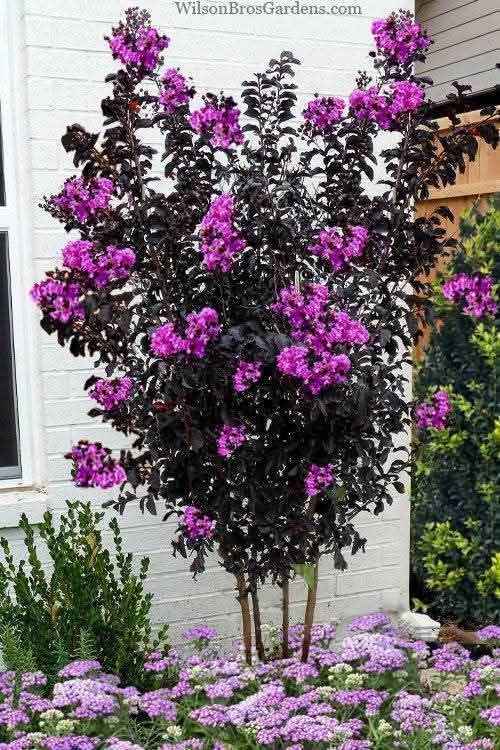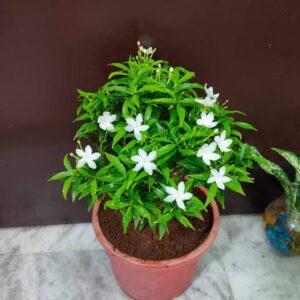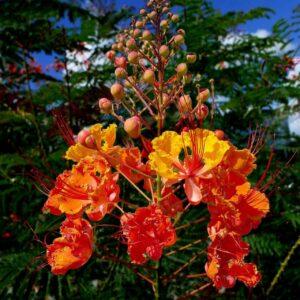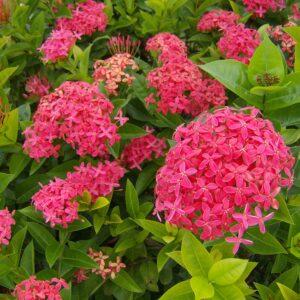Lagerstroemia Gul-e-Fanoos – The Elegant Summer Bloomer
The Lagerstroemia genus includes several species of deciduous trees and shrubs prized for their long-lasting, colorful summer blooms, striking bark, and graceful form. Commonly known in South Asia as Gul-e-Fanoos (meaning “”Lantern Flower”” in Urdu/Hindi), it is most popular for its lavish clusters of crinkled flowers that resemble crepe paper—hence the English name Crape Myrtle.
Lagerstroemia is a staple in urban landscaping, gardens, and avenues, known for its low maintenance, high ornamental value, and multi-seasonal beauty.
🌿 General Description
Botanical name: Lagerstroemia indica, Lagerstroemia speciosa (Pride of India), and others
Common names: Crape Myrtle, Gul-e-Fanoos, Pride of India, Banaba Tree
Plant type: Flowering deciduous shrub or small tree
Height: 6–25 feet (2–8 meters), depending on species and pruning
Spread: 4–15 feet (1.2–4.5 meters)
Foliage: Green leaves that turn yellow, red, or orange in autumn
Flowers: Pink, purple, lavender, white, or red; in fluffy, conical clusters
Blooming season: Late spring through summer (May–September)
☀️ Light and Temperature Requirements
Sunlight:
Needs full sun for best flowering—at least 6 hours daily
Less sun = fewer and smaller blooms
Temperature:
Thrives in warm climates (20–40°C / 68–104°F)
Hardy in USDA zones 7–11
Can tolerate light frost but severe cold may damage top growth
🌞 The more sun it gets, the more vibrant and profuse the blooms.
💧 Watering Routine
Young plants (first year):
Water deeply 2–3 times per week to help root development
Established trees:
Water once a week during dry or hot periods
Tolerates short droughts once mature
💡 Avoid soggy soil—root rot may develop.
Mulching helps retain moisture and reduce weed competition.
🌱 Soil and Fertilizer Requirements
Soil:
Prefers well-drained loamy or sandy soil
Tolerates a wide range of soil types (acidic to slightly alkaline)
pH: Ideal range is 5.5 to 7.5
Fertilizer:
Apply a balanced fertilizer (10-10-10 or 14-14-14) in early spring
A second feeding in mid-summer boosts blooming
Organic compost or aged manure improves soil fertility naturally
⚠️ Avoid too much nitrogen—it encourages leafy growth over flowers.
✂️ Pruning and Maintenance
When to prune:
Late winter or very early spring, before new growth starts
How to prune:
Remove:
Dead or crossing branches
Suckers from the base
Thin branches to improve airflow and shape
Avoid “”topping”” (cutting off top growth aggressively)—this weakens structure and reduces flowering.
✂️ Light shaping after flowering may encourage a second flush of blooms.
🌿 Propagation Methods
Softwood Cuttings (Spring–Early Summer):
Take 6–8 inch cutting from young growth
Dip in rooting hormone and place in moist soil or cocopeat
Keep in shade and mist regularly until rooted (3–4 weeks)
Hardwood Cuttings (Late Fall–Winter):
Root success is slower but still effective
Seeds (less common):
Collect dried seed pods in autumn
Sow in well-draining soil; germination in 2–3 weeks
🌱 Cutting propagation is faster and preserves the flower color/type of the parent plant.
🐛 Pests and Diseases
Generally hardy, but may face:
Powdery mildew (especially in humid or shady areas)
Aphids
Whiteflies
Leaf spot and sooty mold
🛡️ Solutions:
Ensure good air circulation (pruning)
Spray with neem oil or insecticidal soap
Avoid overhead watering
💡 Select mildew-resistant varieties if planting in humid climates.
🎍 Landscape Uses
Ideal for avenues, front yards, garden borders, or flowering screens
Can be grown as a small multi-trunk tree or large shrub
The peeling bark and fall color provide year-round appeal
Pairs well with bougainvillea, hibiscus, and ornamental grasses.
✅ Conclusion
The Lagerstroemia (Gul-e-Fanoos) is a beloved landscape tree in tropical and subtropical regions, admired for its summer flowers, autumn foliage, and ornamental bark. With minimal care—sun, water, and seasonal pruning—it will thrive and reward you with months of brilliant color and charm. Whether as a standalone feature or part of a flowering hedge, it’s a standout performer in any warm-climate garden.
“





Reviews
There are no reviews yet.